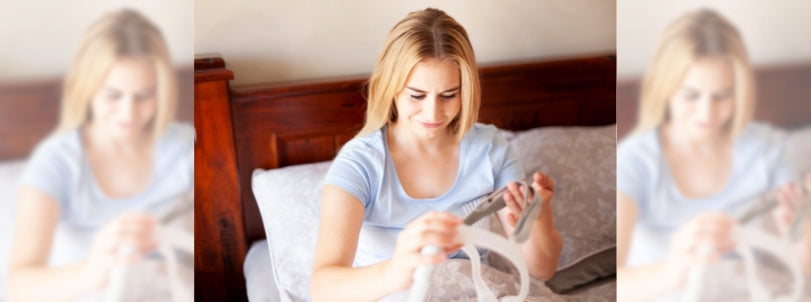
Who Needs a CPAP Device? Find Out if it’s Right for You
Do you count yourself as one of the 39 million Americans who suffer from obstructive sleep apnea? If so, there is little doubt that you are already aware of the complications that this chronic condition can cause.
If you have been recently diagnosed and aren’t yet aware of all the various treatment options, you may want to learn about processes that can have a significant impact on your long-term prognosis. One of the important factors to determine is whether or not you require the ongoing use of a continuous positive airway pressure (CPAP) device. Who needs a CPAP device and what benefits do these devices offer their users? Let’s address these points below.
What Exactly is a CPAP Machine?
When determining who needs a CPAP device, we first need to understand what it is. A CPAP device is one of a series of options commonly referred to as PAP therapy. PAP is an acronym for “positive airway pressure”. The core intention of a CPAP is to provide the user with a supply of air that is pressurized slightly higher than ambient conditions.
So, why is this important? Obstructive sleep apnea (OSA) involves airways that become narrow (or even blocked) during the overnight hours. The ability to access pressurized air through the use of a pumping unit and a facemask helps to ensure that your airways remain open. In turn, you are less likely to experience common symptoms such as choking, loud snoring, and broken sleep patterns.
Are There Different Types of PAP Therapy?
Medicine has evolved to a point where there are now several PAP variants to consider. Determining whether you will be one of those who needs a CPAP device or another device will often be determined by a sleep specialist or your primary care physician. In addition to the CPAP device, there are a few other commonly used devices:
APAP
APAP is an abbreviation for “auto-titrating CPAP”. APAP devices are able to automatically adjust the air pressure, enabling them to deliver the right amount in accordance with the condition of the user’s airways while asleep. APAP devices may be used by those who find it difficult to tolerate traditional CPAP therapy.
BiPAP
A BiPAP is somewhat similar to an APAP device, as it will provide air at varied pressures. The primary difference is that these pressures automatically change depending on whether the user is inhaling or exhaling. This is thought to offer a slightly more effective treatment due to changes in airflow – where lower pressures while exhaling may provide an additional level of relief. A BiPAP device could represent the first line of obstructive sleep apnea treatment, or it may be employed in the event that a standard CPAP device is not producing the desired results.
ASV
A final variant is known as an ASV (adaptive servo-ventilation) device. ASVs essentially share many common features with both APAPs and BiPAPs in terms of automatically adjusted pressure settings. One unique feature is that an ASV will deliver air at a higher volume if the user stops breathing entirely while asleep. ASV therapy is more commonly used by individuals who also experience central sleep apnea, rather than obstructive sleep apnea.
Does Everyone with OSA Require Treatment with a CPAP Machine?
Since there are various device types to prescribe for disordered breathing during sleep, it’s important to discern who needs a CPAP device versus another device. You may also wonder whether there are any instances where CPAP devices are considered optional.
The answer is determined by the severity of symptoms in those with obstructive sleep apnea. Harvard Medical School, for instance, notes that those who only experience light to mild symptoms may not require a CPAP device during the overnight hours. These individuals may not even be aware they are experiencing symptoms. However, more severe cases of obstructive sleep apnea will normally require some type of medical intervention in the form of a CPAP device.
How Long Will it Take to Experience Results?
Assuming you have consulted with your primary care physician and been recommended CPAP treatment, you may now want to know what results you can expect. Will positive outcomes be experienced from night one, or may progress be slower and less obvious? This once again depends on the type of device you use, the severity of your symptoms, and how strictly you choose to follow the recommended regimen. Furthermore, there can be instances when specific settings (such as pressure) may need to be adjusted to meet your personal requirements. In the event that you are able to obtain a sound night of rest, you can rest assured the unit is functioning as it should.
Are There Any Other Types of Treatment?
Although the science associated with CPAP devices has advanced significantly in recent years, these will not necessarily provide relief to 100 per cent of users. In some instances, additional treatment options may need to be considered. For instance, oral appliances will help to keep your throat open, and may be more tolerable when compared to a CPAP device. Surgical interventions are also options in more severe cases, although these tend to be recommended only when other palliative measures have failed.
Surgeries might involve:
- Removing tissue from around the top of the throat and the mouth (known as a uvulopalatopharyngoplasty)
- Shrinking oral tissues through the use of intense radio frequencies
- Physically repositioning the jaw
- Inserting a device that stimulates the nerves in and around the tongue
When considering if you’ll be one of the individuals who needs a CPAP device, the good news is that many individuals dealing with obstructive sleep apnea will normally experience a significant amount of relief through the use of this device. If you are tired of being tired and your symptoms are ongoing, it is time to speak with a primary care doctor or a sleep specialist to discuss many viable treatment options.
